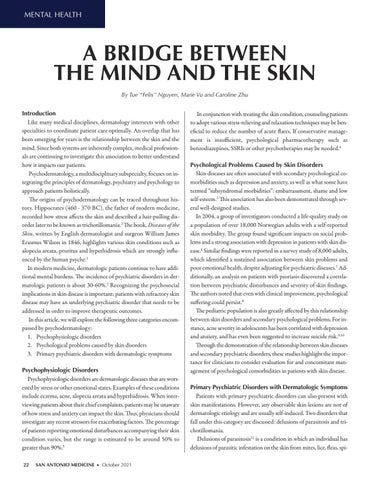MENTAL HEALTH
A BRIDGE BETWEEN THE MIND AND THE SKIN By Tue “Felix” Nguyen, Marie Vu and Caroline Zhu
Introduction Like many medical disciplines, dermatology intersects with other specialties to coordinate patient care optimally. An overlap that has been emerging for years is the relationship between the skin and the mind. Since both systems are inherently complex, medical professionals are continuing to investigate this association to better understand how it impacts our patients. Psychodermatology, a multidisciplinary subspecialty, focuses on integrating the principles of dermatology, psychiatry and psychology to approach patients holistically. The origins of psychodermatology can be traced throughout history. Hippocrates (460 - 370 BC), the father of modern medicine, recorded how stress affects the skin and described a hair-pulling disorder later to be known as trichotillomania.1 The book, Diseases of the Skin, written by English dermatologist and surgeon William James Erasmus Wilson in 1846, highlights various skin conditions such as alopecia areata, pruritus and hyperhidrosis which are strongly influenced by the human psyche.1 In modern medicine, dermatologic patients continue to have additional mental burdens. The incidence of psychiatric disorders in dermatologic patients is about 30-60%.2 Recognizing the psychosocial implications in skin disease is important; patients with refractory skin disease may have an underlying psychiatric disorder that needs to be addressed in order to improve therapeutic outcomes. In this article, we will explore the following three categories encompassed by psychodermatology: 1. Psychophysiologic disorders 2. Psychological problems caused by skin disorders 3. Primary psychiatric disorders with dermatologic symptoms Psychophysiologic Disorders Psychophysiologic disorders are dermatologic diseases that are worsened by stress or other emotional states. Examples of these conditions include eczema, acne, alopecia areata and hyperhidrosis. When interviewing patients about their chief complaints, patients may be unaware of how stress and anxiety can impact the skin. Thus, physicians should investigate any recent stressors for exacerbating factors. The percentage of patients reporting emotional disturbances accompanying their skin condition varies, but the range is estimated to be around 50% to greater than 90%.3 22
SAN ANTONIO MEDICINE • October 2021
In conjunction with treating the skin condition, counseling patients to adopt various stress-relieving and relaxation techniques may be beneficial to reduce the number of acute flares. If conservative management is insufficient, psychological pharmacotherapy such as benzodiazepines, SSRIs or other psychotherapies may be needed.4 Psychological Problems Caused by Skin Disorders Skin diseases are often associated with secondary psychological comorbidities such as depression and anxiety, as well as what some have termed “subsyndromal morbidities”: embarrassment, shame and low self-esteem.5 This association has also been demonstrated through several well-designed studies. In 2004, a group of investigators conducted a life-quality study on a population of over 18,000 Norwegian adults with a self-reported skin morbidity. The group found significant impacts on social problems and a strong association with depression in patients with skin disease.6 Similar findings were reported in a survey study of 8,000 adults, which identified a sustained association between skin problems and poor emotional health, despite adjusting for psychiatric diseases.7 Additionally, an analysis on patients with psoriasis discovered a correlation between psychiatric disturbances and severity of skin findings. The authors noted that even with clinical improvement, psychological suffering could persist.8 The pediatric population is also greatly affected by this relationship between skin disorders and secondary psychological problems. For instance, acne severity in adolescents has been correlated with depression and anxiety, and has even been suggested to increase suicide risk.9,10 Through the demonstration of the relationship between skin diseases and secondary psychiatric disorders, these studies highlight the importance for clinicians to consider evaluation for and concomitant management of psychological comorbidities in patients with skin disease. Primary Psychiatric Disorders with Dermatologic Symptoms Patients with primary psychiatric disorders can also present with skin manifestations. However, any observable skin lesions are not of dermatologic etiology and are usually self-induced. Two disorders that fall under this category are discussed: delusions of parasitosis and trichotillomania. Delusions of parasitosis11 is a condition in which an individual has delusions of parasitic infestation on the skin from mites, lice, fleas, spi-







